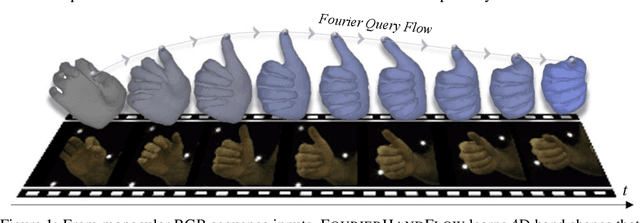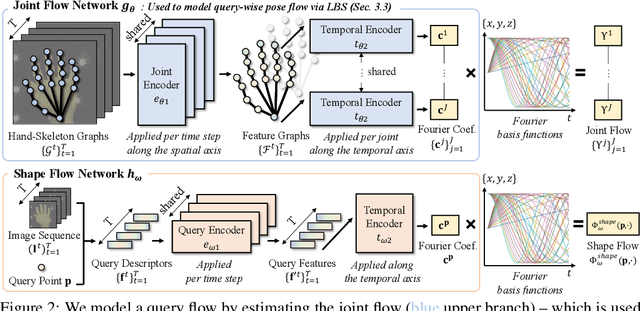Junbong Jang
FourierHandFlow: Neural 4D Hand Representation Using Fourier Query Flow
Jul 16, 2023



Abstract:Recent 4D shape representations model continuous temporal evolution of implicit shapes by (1) learning query flows without leveraging shape and articulation priors or (2) decoding shape occupancies separately for each time value. Thus, they do not effectively capture implicit correspondences between articulated shapes or regularize jittery temporal deformations. In this work, we present FourierHandFlow, which is a spatio-temporally continuous representation for human hands that combines a 3D occupancy field with articulation-aware query flows represented as Fourier series. Given an input RGB sequence, we aim to learn a fixed number of Fourier coefficients for each query flow to guarantee smooth and continuous temporal shape dynamics. To effectively model spatio-temporal deformations of articulated hands, we compose our 4D representation based on two types of Fourier query flow: (1) pose flow that models query dynamics influenced by hand articulation changes via implicit linear blend skinning and (2) shape flow that models query-wise displacement flow. In the experiments, our method achieves state-of-the-art results on video-based 4D reconstruction while being computationally more efficient than the existing 3D/4D implicit shape representations. We additionally show our results on motion inter- and extrapolation and texture transfer using the learned correspondences of implicit shapes. To the best of our knowledge, FourierHandFlow is the first neural 4D continuous hand representation learned from RGB videos. The code will be publicly accessible.
Unsupervised Contour Tracking of Live Cells by Mechanical and Cycle Consistency Losses
Mar 15, 2023Abstract:Analyzing the dynamic changes of cellular morphology is important for understanding the various functions and characteristics of live cells, including stem cells and metastatic cancer cells. To this end, we need to track all points on the highly deformable cellular contour in every frame of live cell video. Local shapes and textures on the contour are not evident, and their motions are complex, often with expansion and contraction of local contour features. The prior arts for optical flow or deep point set tracking are unsuited due to the fluidity of cells, and previous deep contour tracking does not consider point correspondence. We propose the first deep learning-based tracking of cellular (or more generally viscoelastic materials) contours with point correspondence by fusing dense representation between two contours with cross attention. Since it is impractical to manually label dense tracking points on the contour, unsupervised learning comprised of the mechanical and cyclical consistency losses is proposed to train our contour tracker. The mechanical loss forcing the points to move perpendicular to the contour effectively helps out. For quantitative evaluation, we labeled sparse tracking points along the contour of live cells from two live cell datasets taken with phase contrast and confocal fluorescence microscopes. Our contour tracker quantitatively outperforms compared methods and produces qualitatively more favorable results. Our code and data are publicly available at https://github.com/JunbongJang/contour-tracking/
 Add to Chrome
Add to Chrome Add to Firefox
Add to Firefox Add to Edge
Add to Edge